
history
This is what Edward Desmond has to say about Kashmir in his book Himalyan Ulster:
On a map of the western Himalayas, the valley of Kashmir shows up as a smooth, oval-shaped patch amid a sea of surrounding peaks in what is today Indias Jammu and Kashmir state.
For thousands of years, travellers, freebooters, and empire builders have set down their breathless impressions of this valley the French writer Francois Bernier called it the paradise of the Indies with its towering pine forests, deep lakes, flower carpeted meadows, and fields of iridescent saffron. The seventeenth century Mughal emperor Jehangir sighed on his death-bed that his last wish was to visit Kashmir. Indians today revere the valley as the place they long to visit, and it serves as the setting for countless romantic Indian films.
Kashmir’s past
Kashmir and the subcontinent has a rich and tumultuous history. We can pick up the pieces in the nineteenth century, but the actual history of Kashmir begins much earlier, before Islam or Hinduism was present on the soil of these lands.
Kashmir has been in existence since 5000 years. Its history can be traced to time immemorial. Kashmir has always been a magnet to immigrants.
Prior to Hinduism in the subcontinent, the Kashmir Valley (called Abhasrsa) traded with the Indus Valley Civilisation. In pre-Vedic times the people who lived in the Indus Valley lived in absolute harmony. There is some confusion as to who were the original inhabitants of the northwestern region of the Indian subcontinent. Many feel that there was a civilisation BEFORE the Dravidians landed in South Asia. Some have ventured to claim that based on the fact that all of Indias neighbours are Oriental, perhaps the original inhabitants of ancient India were Oriental in ethnic origin.
When the Arayans arrived in South Asia in waves, the Huns, the Rajputs and others were always in conflict. After the Hindu conflicts died down, around the 8th century B.C Buddhism took root in the subcontinent. Buddhist-Hindu wars claimed many lives.
The Kashmir valley was mostly inhabited by people that included sun worshippers, Zorastarians, and Buddhists. Kashmir became an important centre of Brahman learning. Brahaman art, literature and philosophy flourished unhindered, on the backs of the untouchables, and the lower caste Hindus. After the 8th century the clear message of Islam was heard in the Valley. It was the Sufis who carried the message of Muhammad to Kashmir. The caste system of the Hindus, the Brahman cruelty, and the practices of Sati, and human sacrifices were fertile grounds for Islam in Kashmir. Slowly but surely, people converted to the message that accorded the Untouchables instant equality among the Muslim brotherhood.
From 1326 to 1819, Muslims improved the lot of the Kashmiris and ruled the Kashmir valley with compassion and honour. The Mughals not only ruled Kashmir, they also brought it art, culture, music, paintings, and architecture that the people had never seen. Wherever the Moghuls lived they brought life with them. The Shalimar Gardens and the Mosques built in the Valley are a testament to the affluence of India in the 16th century.
Jahangir was the wealthiest man on the planet and he spent his money to create luxury for his people. Kashmir benefited too. Hindu temples built in the sixteenth century were subsidized, and today they remain in the valley.
Hindus thrived in the Valley. The forefathers of the Nehrus lived and prospered in Kashmir during the Muslim rule. During the regimes of chaos during the Afghan rule (1752-1819) and the arrival of Alexander the Great and his Greek army, many Muslims lost their lives due to persecution.
Kashmir was sold to the Sikhs following the defeat of Sikhs at the hands of the British in 1846, Gulab Singh, the cruel and dim-witted Dogra ruler of Jammu, acquired Kashmir from the British and ruthlessly tired to rule the state of Jammu & Kashmir.
The period of the Dogra rulers was the darkest in the history of the state. Gulab Singh was a ruthless ruler. He ruled by edict only, the edict of the Kirpan. Thus Jammu & Kashmir became a Princely State and remained so till 1947 until India occupied it.
a short Summary
The present conflict between India and Pakistan revolves around the territory called Kashmir, which is located to the north of both countries. Both India and Pakistan say Kashmir is a part of their territory.
Kashmir was one of many princely states in India. Under the Partition Plan in 1947, these states were free to join either India or Pakistan. The ruler of Kashmir, the Maharaja Hari Singh , was Hindu while the majority of the population was, and still remains, Muslims. The Maharaja had three choices - join with India, join with Pakistan or remain independent. However, Hari Singh wanted Jammu and Kashmir to remain independent. In order to buy some time, he signed a stand-still agreement, which sidestepped the agreement that each princely state would join either India or Pakistan. Later there was a revolution by Muslims in the western part of the kingdom and the raiders from North-West Frontier Province and the Tribal Areas feared that Hari Singh might join the Indian Union. In October 1947, supported by the Pakistani Army, they attacked Kashmir and tried to take over control of Kashmir. Initially Hari Singh tried to resist their progress but failed. Hari Singh then requested the Indian Union to help. India responded that it could not help unless Kashmir joined India. So on 26 October 1947, Kashmir accession papers were signed and Indian troops were airlifted to Srinagar. Fighting ensued between the Indian Army and Pakistani Army, with control stabilizing more or less around what is now the "Line of Control" (COL).
This event is much in dispute. Pakistan argues that the Maharaja was forced by India to sign over Kashmir to them while India maintains that this was not the case. Pakistan, but also the Kashmiris themselves argue that the people of Kashmir (Kashmiris) were never given a chance to decide their future as the Maharaja never consulted with them. Since Muslims make up the majority of the population, Pakistan claims that Kashmir should be a part of Pakistan.
It should be pointed out that in accepting Kashmir as a part of India, the Governor General of India, Lord Mountbatten, made it clear that this decision would be made final only when the people of Kashmir vote in a plebiscite or referendum on the matter. India accepted this position but has never allowed such referendum to take place. The United nations passed three resolutions calling for a plebiscite to be held but India ignored such calls. Many believe that India refuses to hold a plebiscite for fear that the majority of Kashmiris would vote to join Pakistan. Since then, India and Pakistan have gone to war twice over Kashmir, the first in 1947-8, and again in 1965. Over the years, sporadic clashes have taken place between the two sides.
Following the first war, the declared “Line of Control” (COL) left two thirds of Kashmir under Indian control and the remaining one-third under Pakistani control. The Indian-controlled part of Kashmir is called Jammu and Kashmir with a population of about 9 million people. The Pakistani-controlled sector is called Azad or Free Kashmir.
divided by the government of Pakistan:
1. Azad Jammu and Kashmir (AJK) - the narrow southern part, 250 miles (400 km) long, with a width varying from 10 to 40 miles (16 to 64 km).
2. Gilgit-Baltistan formerly called Federally Administered Northern Areas (FANA) - is the much larger area to the north of AJK, 72,496 square kilometres (27,991 sq mi); it was directly administered by Pakistan as a de facto dependent territory, i.e., a non-self-governing territory. However it was officially granted full autonomy on August 29, 2009.
An area of Kashmir that was once under Pakistani control is the Shaksgam tract—a small region along the northeastern border of the Northern Areas that was provisionally ceded by Pakistan to the People's Republic of China in 1963 and which now forms part of China's Uygur Autonomous Region of Xinjiang.
The "Line of Control" has remained unchanged since the 1972 Simla Agreement, which bound the two countries "to settle their differences by peaceful means through bilateral negotiations."
Some political experts claim that, in view of that pact, the only solution to the issue is mutual negotiation between the two countries without involving a third party, such as the United Nations.
India and Pakistan, two estranged siblings - their rivalries over five decades have prevented both countries from realizing their full economic and geopolitical potential.
The two countries have fought three wars, two of them over the disputed region of Kashmir.
The region is small, but nestled in the foothills of the Himalayas its strategic importance and beauty make it a prized possession.
August 15, 1947 - India and Pakistan gain independence from Britain.
October 27, 1947 - Kashmir becomes part of India.
January 1948 - India and Pakistan go to war over Kashmir and finally agree to withdraw all troops behind a mutually agreed ceasefire line, later known as the Line of Control.
August 5, 1965 - India and Pakistan at war again over Kashmir. The war ends when both countries decide to adopt a UN-sponsored resolution to stick to the Line of Control.
May 7, 1999 - The Indian Army patrols detect intruders on Kargil ridges in Kashmir. India fights to regain lost territory.
March 19, 2000 - Then U.S. President Bill Clinton arrives in India, beginning his six-day visit to South Asia, partly in an attempt to ease relations between Pakistan and India over the disputed region of Kashmir.
July 25, 2000 - Hizbul Mujahedeen, a pro-Pakistan Kashmiri militant group, declares a unilateral ceasefire for three months in Jammu and Kashmir.
August 3, 2000 - India begins peace talks with Hizbul Mujahedeen, in Srinagar.
August 8, 2000 - Hizbul Mujahedeen calls off its 2-week-old ceasefire and orders its forces to resume fighting against Indian troops.
November 19, 2000 - Indian Prime Minister Atal Bihari Vajpayee announces that security forces will suspend combat operations against militants in Jammu and Kashmir state during the Islamic holy month of Ramadan.
27 November 2000 - India puts a ceasefire into effect in Kashmir.
December 23, 2000 - Pakistan-based guerrilla group, Lashkar-e-Taiba, claims responsibility for a deadly attack on New Delhi's historic Red Fort.
February 22, 2000 - Prime Minister Vajpayee extends the unilateral ceasefire by three months.
April 27, 2001 - An executive from Kashmir's separatist All Parties Huriyat Conference (APHC), which claims to be the premier political representative of the Kashmiri people, rejects an Indian offer for a dialogue.
May 23, 2001 - India ends a six-month military ceasefire against Islamic guerillas in Kashmir while also inviting Pakistani military ruler, General Pervez Musharraf, to peace talks aimed at ending five decades of hostilities between the two countries.
May 28, 2001 - India's peace negotiator for Kashmir, Krishan Chander Pant, visits the territory to meet a cross-section of people from Pakistan and Kashmir.
India refuses to yield any ground in talks and insists that the territory is an integral part of India and rejects Pakistan's calls for a referendum on the future of Kashmir.
May 28, 2001 - Pakistan's military ruler, General Pervez Musharraf, formally accepts an Indian invitation for summit talks focused firmly on the Kashmir dispute.
June 18, 2001- Pakistan's military ruler, General Pervez Musharraf, announces a visit to India from July 14 to 16 for the first summit talks between the neighboring states in two years.
June 20, 2001 - Musharraf dismisses President Rafiq Tarar as the nation's ceremonial head of state, dissolves the national and provisional assemblies and declares himself as new Pakistani president.
July 4, 2001 - India says it is releasing more than 400 Pakistani prisoners from its jails as a goodwill gesture 10 days ahead of the India-Pakistan summit meeting in New Delhi.
July 4, 2001 - President Musharraf issues an executive order, giving the president boundless powers through a newly devised National Security Council.
July 14-16, 2001 - President General Pervez Musharraf and Prime Minister Atal Behari Vajpayee meet in Agra, India for a three-day summit. The talks fail to produce a joint statement on Kashmir.
July 24, 2001 - Abdul Hamid Tantray, chief spokesman of the Hizbul Mujahadeen, one of Kashmir's largest militant groups, dies in what Indian authorities call an "encounter" with police in the village of Paloo.
August 8, 2001 - India imposes an indefinite curfew in Jammu as tension runs high in the city after the massacre of 11 people at a railway station.
October 1, 2001 - Militants attack the Kashmiri assembly in Srinagar, leaving 38 people dead. Kashmir chief minister Farooq Abdullah urges the Indian government to launch a crackdown on militant training camps across the border in Pakistan.
October 18, 2001 -- The United States says its campaign against terrorism will pursue Kashmiri militants.
December 13, 2001 - Unidentified men attack the Indian parliament in New Delhi. Fourteen people are killed, including the five assailants.
December 20, 2001 - The Indian army deploys troops on its border with Pakistan in the northern states of Kashmir and Punjab in response to a Pakistani troop build-up across the frontier.
December 25, 2001 - Pakistan detains the leader of an Islamic organization blamed by India for the suicide attack on the Indian parliament.
December 27, 2001 - Indian police verify reports that a group of al Qaeda members led by a close associate of Osama bin Laden entered Kashmir.
January 2, 2002 - India stops long-distance calls from all public telephone offices in Kashmir to prevent militants from communicating with each other.
New Delhi tells Pakistan to wipe out Pakistan-based Kashmir separatist groups Lashkar-e-Taiba and Jaish-e-Mohammad. Row triggers military build-up, diplomatic sanctions, and closure of transport links.
January 7, 2002 - After weeks of heated rhetoric, accusations and military posturing, Indian Prime Minister Atal Bihari Vajpayee says at the South Asian Regional Cooperation meeting in Kathmandu, Nepal, that his nation is ready for "dialogue" with its fellow nuclear power.
January 9, 2002 - A siege between Indian troops and two militants holed up in a mosque in Kashmir ends after one of the gunmen was killed and the other surrendered.
January 11, 2002 - India's army chief says the nation is ready for war with Pakistan and would use its nuclear weapons if its neighbor were to launch a nuclear strike first.
January 13, 2002 - Welcoming Pakistan President Pervez Musharraf's pledge to crack down on religious extremists, India says it will judge its neighbor's actions before it begins a military de-escalation or resumes dialogue.
January 13, 2002 -- Two suspected militants were shot dead after they allegedly tried to attack a paramilitary camp in Srinigar.
January 16, 2002 - U.S. Secretary of State Colin Powell visits Islamabad on the first stage of a South Asian tour designed to kickstart a dialogue between India and Pakistan.
January 21, 2002 - Unidentified gunmen kill eight members of a family including several women and children in a small village in Kashmir.
February 4, 2002 - The radical Kashmiri group Jaish-e-Mohammed suspend operations in the rest of India in order to focus on Kashmir.
February 17, 2002 - Militants kill eight Hindus in Kashmir.
February 25, 2002 - India's parliament resumes for the first time since a suicide attack in December with a new strategy from the government on Kashmir designed to stamp out terrorism.
March 25, 2002 - A Kashmiri separatist leader was arrested under an anti-terrorism law in connection with the seizure of large sums of cash India says was smuggled into the region from Nepal by two activists.
May 14, 2002 - Suspected Islamic militants open fire on an army camp in Indian Kashmir, killing at least 30 people and wounding 40, marring a new effort to ease the tension between India and Pakistan.
May 17, 2002 - A blast rips through the capital of Kashmir as India's parliament debates how to respond to an earlier deadly attack in the disputed region.
May 19, 2002 - Fourteen people, including eight security personnel, were killed and 17 injured in fresh rebel attacks Kashmir.
May 20, 2002 - Three Pakistani villagers were killed after Pakistani and Indian troops traded fire across their tense border in Kashmir, a Pakistani official said.
May 21, 2002 - Gunmen open fire on a meeting of Indian Kashmir's main separatist Hurriyat alliance, killing separatist leader Abdul Gani Lone.
May 22, 2002 - A Pakistani girl was killed and three people wounded as Indian and Pakistani forces face off in Kashmir trade fire. India Prime minister Atal Behari Vajpayee heads for India's front lines.
May 2, 2003 - India and Pakistan restore diplomatic ties.
July 11, 2003 - Delhi-Lahore bus service resumes.
September 24, 2004 - Prime Minister Manmohan Singh and President Musharraf meet in New York during UN General Assembly.
July, 2006 - Second round of Indo-pakistan peace talks.
Feb, 2007 - Samjhauta Express firebombed, 67 killed.
Jun 24, 2008 - Kashmir on fire over land transfer controversy, PDP office set ablaze.
Aug 9, 2008 - Indian Hindu Atrocities in Kashmir
Aug 23, 2008 - Half a million people gather at Freedom March.
Jul 22, 2009 - USA-Obama: Conference to discuss Kashmir Options.
Jul 26, 2009 - Kashmir is a nuclear flashpoint.
Oct 11, 2009 - Pakistan, India clash at UN over Kashmir.
Apr 4, 2010 - Roadmap for Kashmir solution exists: Blake.
Hari Parbat Fort, built in 1808
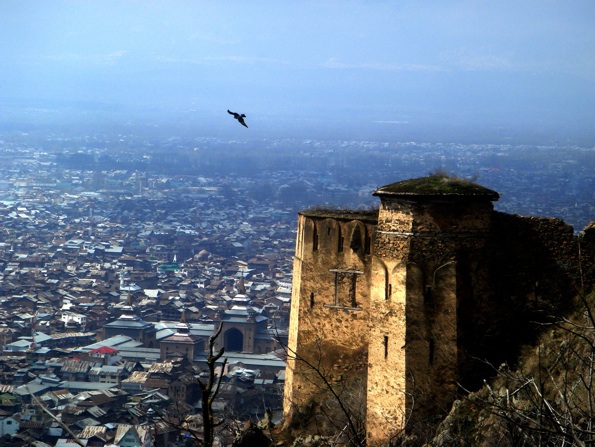
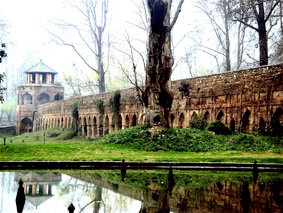
Lake Dal



Mogul Garden, Shalimar
Ranaiwari, Srinagar
Floating Vegetable Gardens
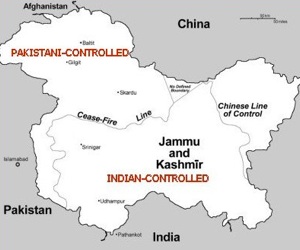
map: Kashmir
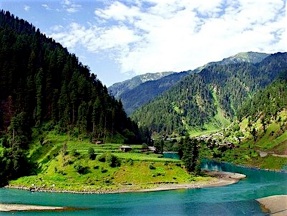
Kashmir the Kingdom of Beauty

Srinarage, Checkpoint
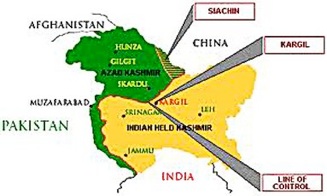
The “Line of Control”
Conflict over Kashmir

































































